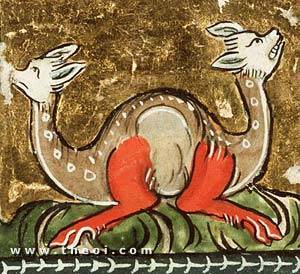AMPHISBAINA
Greek Name
Αμφισβαινα
Αμφισβαιναι
Transliteration
Amphisbaina
Amphisbainai
Latin Spelling
Amphisbaena
Amphisbaenae
Translation
Walking both Ways
(amphi-, bainô)

THE AMPHISBAINA (Amphisbaena) was a fabulous Libyan serpent with a head at each end of its body.
A similar tortoise-like creature was located in the legendary Heliades Islands of the far south.
The creature was popular in Medieval bestiaries.
CLASSICAL LITERATURE QUOTES
THE AMPHISBAENA SERPENT
Aeschylus, Agamemnon 1232 ff (trans. Weir Smyth) (Greek tragedy C5th B.C.)
:
"Such boldness has she [Klytaimestra (Clytemnestra)], a woman to slay a man. What odious monster shall I
fitly call her? An Amphisbaina (Amphisbaena)? Or a Skylla (Scylla), tenanting the rocks, a pest to mariners, a
raging, devil's mother, breathing relentless war against her husband?"
Aelian, On Animals 8. 8 (trans. Scholfield) (Greek natural history C2nd A.D.)
:
"Nikandros (Nicander) asserts that the slough of the Amphisbaina (Amphisbaena) if wrapped round a
walking-stick drives away all snakes and other creatures which kill not by biting but by striking."
Aelian, On Animals 9. 23 :
"The Amphisbaina (Amphisbaena) is a snake with two head, one at the top and one in the direction of the
tail. When it advances, as need for a forward movement impels it, it leaves one end behind to serve as tail,
while the other it uses as a head. Then again if it wants to move backwards, it uses the two heads in exactly
the opposite manner from what it did before."
Pliny the Elder, Natural History 8. 85 (trans. Rackham) (Roman encyclopedia C1st
A.D.) :
"The Amphisbaena [serpent] has a twin head, that is one at its tail-end as well, as though it were not
enough for poison to be poured out of one mouth."
Nonnus, Dionysiaca 5. 146 ff (trans. Rouse) (Greek epic C5th A.D.) :
"[Description of the mythical cursed necklace of Harmonia :] It was like a serpent with starspangled back
and coiling shape. For as the twoheaded Amphisbaina (Amphisbaena) in very sooth winds the coils between and
spits her poison from either mouth, rolling along and along with double-gliding motion, and head crawling joins
with head while she jumps twirling waves of her back sideways: so that magnificent necklace twisted shaking its
crooked back, with its pair of curving necks, which came to meet at the midnipple, a flexible twoheaded serpent
thick with scales; and by the curving joints of the work the golden circle of the moving spine bent round, until
the head slid about with undulating movement and belched a mimic hissing through the jaws. With the two mouths
on each side, where is the beginning and the end, was a golden eagle that seemed to be cutting the open air,
upright between the serpent's heads, high-shining with fourfold nozzle of the four wings [i.e. an eagle grasps
the amphisbaina in its claws]."
THE AMPHISBAENA TORTOISE
Diodorus Siculus, Library of History 2. 58. 2 - 4 (trans. Oldfather) (Greek historian
C1st B.C.) :
"[An amphisbaena-like tortoise was said to inhabit the legendary Seven
Isles of the Indian Ocean :] There are also animals among them, we are told, which are small in size but
the object of wonder by reason of the nature of their bodies and the potency of their blood; for they are round
in form and very similar to tortoises, but they are marked on the surface by two diagonal stripes, at each end
of which they have an eye and a mouth; consequently, through seeing with four eyes and using as many mouths, yet
it gathers its food into one gullet, and down this its nourishment is swallowed and all flows together into one
stomach; and in like manner its other organs and all its inner parts are single. It also ahs beneath its all
around its body many feet, by means of which it can move in whatever direction it pleases. And the blood of this
animal, they say, has a marvellous potency; for it immediately glues on to its place any living member that has
been severed; even if a hand or the like should happen to have been cut off, by the use of this blood it is
glued on again, provided that the cut is fresh, and the same thing is true of such other parts of the body as
are not connected with the regions which are vital and sustain the person's life."
SOURCES
GREEK
- Aeschylus, Agamemnon - Greek Tragedy C5th B.C.
- Diodorus Siculus, The Library of History - Greek History C1st B.C.
- Aelian, On Animals - Greek Natural History C2nd - 3rd A.D.
- Nonnus, Dionysiaca - Greek Epic C5th A.D.
ROMAN
- Pliny the Elder, Natural History - Latin Encyclopedia C1st A.D.
OTHER SOURCES
Other references not currently quoted here: Aristophanes Frag 19D, Nicander Theriaca 372.
BIBLIOGRAPHY
A complete bibliography of the translations quoted on this page.